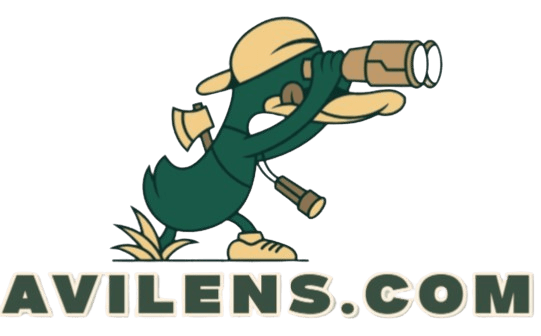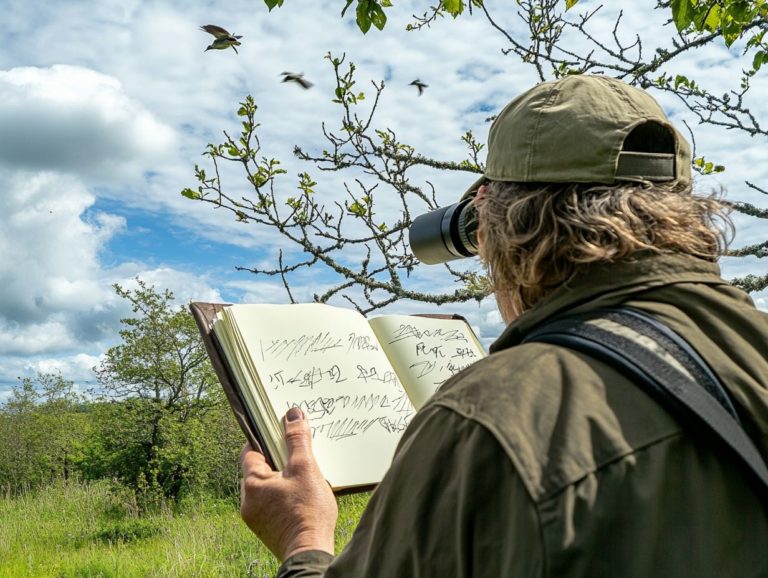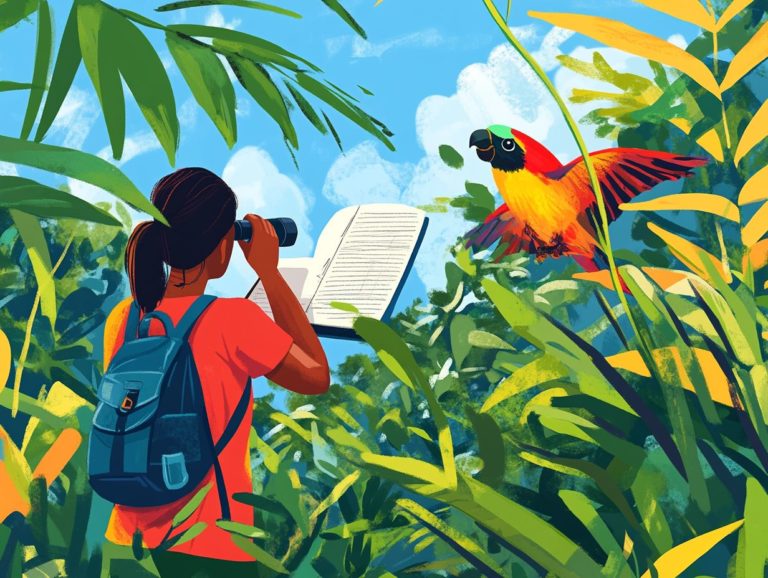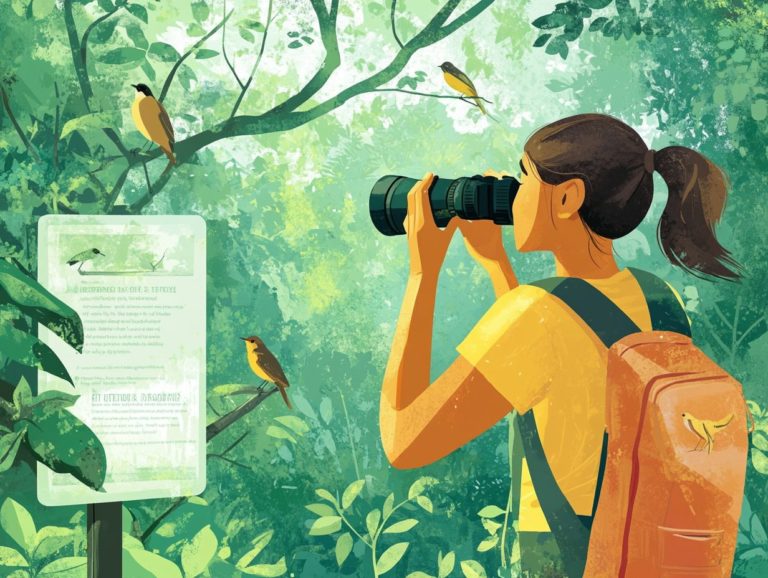How Can I Identify Bird Songs and Calls?
Bird songs and calls serve as vital means of communication among birds and play important roles in their habitats. Birdwatchers and conservationists who can identify these sounds enhance their experiences and contribute to conservation efforts, allowing them to better understand and appreciate the avian world.
Discover why recognizing bird songs and calls is essential for every bird lover! This article presents practical tools and techniques for identification and offers useful suggestions for improving your identification skills. It includes a list of common bird calls, discusses the challenges associated with identifying them, and examines how this knowledge fosters a deeper understanding and appreciation of birds through learning to recognize their unique vocalizations.
Contents
- Key Takeaways:
- Why is it Important to Identify Bird Songs and Calls?
- How to Identify Bird Songs and Calls
- Tips for Improving Bird Song and Call Identification Skills
- Practice and Resources for Learning
- Common Bird Songs and Calls
- Challenges and Limitations of Identifying Bird Songs and Calls
- Frequently Asked Questions
- How Can I Identify Bird Songs and Calls?
- What is the best way to identify bird songs and calls?
- Are there any online resources that can help me identify bird songs and calls?
- Do I need any special equipment to identify bird songs and calls?
- What are some common features of bird songs and calls that can help with identification?
- Can bird songs and calls change over time?
Key Takeaways:
- Bird songs and calls are unique vocalizations used by birds for various purposes, such as attracting mates and defending territories.
- Identifying bird songs and calls is important for birdwatchers and conservationists, as it aids in bird identification, behavior studies, and habitat preservation.
- Tools and techniques such as recordings, apps, and mnemonic devices can aid in the identification of bird songs and calls. Regular practice and use of resources can improve your skills.
What are Bird Songs and Calls?
Bird vocalizations, known as bird sounds, can be categorized into two main types: songs and calls. Bird songs are typically long, complex, and melodic sounds produced mainly by male birds during the breeding season. These songs serve to attract females and establish breeding territories.
In contrast, bird calls are generally short, simple, and high-pitched sounds made by both males and females throughout the year. Calls convey essential information about species calling within their habitats, including location, food availability, and potential dangers.
Understanding bird songs and calls is crucial for effective communication among birds and enhances the experience of birdwatching. The ability to identify various bird sounds significantly improves your capacity to observe and study their natural behaviors, fostering a deeper connection to the natural world. This practice, often referred to as “birding by ear,” involves recognizing birds solely by sound or supplementing visual observations with knowledge of their vocalizations.
Bird Songs and Calls: Examples
The song of the American Robin is a well-known indicator of spring’s arrival in North America. Males sing to attract females and defend their territories from other males. Similarly, the calls of the Common Yellowthroat help establish the locations of individual birds within their habitats and can convey information about food sources and potential threats, making it essential to identify birds for conservation efforts.
Bird Songs and Calls: Resources
The study of bird songs and calls can be greatly enriched through resources like the Cornell Lab of Ornithology’s “All About Birds” website, which offers thousands of audio recordings for aspiring birders to familiarize themselves with the sounds of various species. Learning to recognize these vocalizations is an essential step in becoming a knowledgeable birdwatcher.
Why is it Important to Identify Bird Songs and Calls?
The ability to identify and recognize bird songs and calls is essential for birdwatchers and conservationists. It enhances birding skills and fosters a deeper connection to the natural world.
Recognizing and identifying bird songs and calls not only aids in determining bird species but also enriches the outdoor learning experience. It allows enthusiasts to better appreciate nature’s beauty, especially during the serene moments of a spring sunrise, when birding by ear is most rewarding.
Understanding bird vocalizations plays a crucial role in conservation efforts by offering valuable insights into species distribution and behavior. This knowledge is critical for the work of organizations like Audubon.
Ready to enhance your birdwatching? Check out these essential tools today!
Benefits for Birdwatchers and Conservationists
Birdwatchers unlock incredible experiences by learning to identify bird songs and calls. These skills enhance their field experiences and contribute to vital conservation efforts. Using sound libraries and audio memory techniques helps improve their ability to recognize various species based on their calls, fostering greater awareness of local biodiversity. This awareness supports initiatives like the National Audubon Society’s BirdCount program.
By utilizing sound libraries from places like the Cornell Lab and honing their audio memory, birdwatchers can learn new bird calls. This practice also helps conservationists gather reliable data to track bird populations and habitats through these vocalizations. Understanding subtle differences in pitch and cadence sharpens observational skills, turning each outing into a fresh adventure.
Sound libraries house extensive collections of bird calls and songs, serving as excellent resources for both novice and seasoned birdwatchers. These libraries aid in memorization and help users connect with the avian world. Repeating sounds and using visual cues—like the bird’s appearance and behavior—can reinforce audio memory.
Successful conservation initiatives, such as the National Audubon Society’s BirdCount program, collect citizen science data to monitor bird populations and changing seasonal patterns, which can be instrumental in preservation efforts.
How to Identify Bird Songs and Calls
Identifying bird songs and calls requires careful listening, practice, and modern tools like Merlin Bird ID and BirdNET. These tools assist birdwatchers in recognizing different species and can dramatically enhance anyone’s ability to identify a range of sounds.
As technology advances, tools like Merlin Bird ID and BirdNET prove invaluable. These applications offer extensive libraries of audio recordings, serving as essential resources for learning and distinguishing various birds in different habitats.
Tools and Techniques for Identification
Using various tools and techniques to recognize bird songs and calls is essential for birdwatchers seeking to enhance their skills and improve outdoor experiences. Comprehensive audio recordings, such as those from the Cornell Lab, along with techniques developed by experts like Ted Parker, provide a solid foundation for sound identification.
By utilizing these resources, birders can refine their abilities to recognize familiar and new bird songs in their surroundings.
Mobile apps like Merlin Bird ID and BirdNET offer sound libraries and user-friendly interfaces to assist in identifying birds by their calls. These apps use machine learning to analyze unique vocal patterns.
Expert birders emphasize the importance of field guides that incorporate visual and audio indicators, bridging the gap between sight and sound. Techniques such as observing patterns and behavior, especially as taught by experts like Ted Parker and Kenn Kaufman, greatly enhance identification accuracy.
By combining these tools with effective techniques, individuals can immerse themselves in the captivating world of avian communication.
Tips for Improving Bird Song and Call Identification Skills
- Practice and Patience: Improving skills is a lifelong journey for birdwatchers, regardless of experience level.
- Embrace Outdoor Learning: Engage in activities like birding by ear during early spring mornings, when songbirds are most active.
- Optimal Opportunities: Use vibrant spring months to develop identification skills while deepening your connection with nature.
Have you ever wondered how many bird species you could identify on your next outing? Get outside and start listening today!
Practice and Resources for Learning
Regular practice is essential for learning to identify bird songs and calls. Numerous resources are available to assist in this process.
Mobile apps designed for identifying bird songs allow individuals to practice recognizing calls in real-time while out in the field. Learning is often more effective when done collaboratively. Joining local birdwatching groups or participating in community events, such as guided walks, can be beneficial. Sharing experiences with others frequently leads to enriching conversations and valuable learning opportunities.
Community events, such as bird counts and guided walks, provide excellent chances for individuals to hone their skills in nature. These events offer practical experience, foster a deeper connection with the environment, and support local conservation efforts. They also raise awareness of species calling in the area. Such initiatives remind us of the collective responsibility required to protect the habitats where birds thrive.
Common Bird Songs and Calls
Bird songs and calls reveal the amazing variety of how birds communicate. Each species produces its own unique sounds. For instance, the American Robin features a cheerful melody, the Barred Owl emits a haunting hoot, and the Common Yellowthroat has a distinctive whistle. Learning to recognize these common bird songs enhances the ability of bird watchers to identify various species and fosters a deeper appreciation for the natural world.
Common Bird Songs and Calls: This list includes examples such as audio recordings of the American Robin Song, Barred Owl Call, and Common Yellowthroat Song.
- American Robin Song
- Barred Owl Call
- Common Yellowthroat Song
Examples and Characteristics
Bird songs and calls exhibit a variety of features. The American Robin (*Turdus migratorius*) produces a cheerful whistle to claim its area. The Barred Owl (*Strix varia*) emits deep hoots to announce its presence and attract mates during the night. The Common Yellowthroat (*Geothlypis trichas*) is known for its distinctive “witchety-witchety-witchety” call, typical of wetland environments.
Bird songs and calls play a crucial role in individual identification, allowing birds to recognize one another. They are also essential for claiming an area and attracting mates. The melodic phrases of the American Robin are iconic sounds of North America. Males sing their songs during the morning and evening, when they are most active. According to the National Audubon Society, their rich, cheerful song can be heard from over a mile away (1.6 km).
Barred Owls use loud, low-pitched hoots that resemble the phrase “who cooks for you, who cooks for you all” to announce their presence and attract mates. These calls fill the woods at night, capturing the attention of curious humans and potential partners.
The Common Yellowthroat, found in wetlands, brushy fields, and weedy areas throughout North America, features adults with a distinctive black mask and a plaintive “witchety-witchety-witchety” call. This call serves both as a mating call and a territorial proclamation, allowing the bird to request responses from potential mates or signal its presence to others in the area.
Challenges and Limitations of Identifying Bird Songs and Calls
Identifying bird songs and calls can be challenging. Factors such as environmental noise, overlapping vocalizations from multiple species, and the extensive diversity of bird songs across different habitats may hinder one’s ability to accurately recognize vocalizations in the field.
Recognizing these challenges helps birdwatchers improve their skills. By understanding these limitations, birdwatchers can cultivate adaptability and persistence in their pursuit of knowledge.
Factors that Affect Identification
Identifying bird songs and calls is a thrilling adventure! However, various factors can make this challenging. For instance, in urban areas, unwanted sounds that make it hard to hear bird songs from traffic and construction can drown out the softer notes of even the loudest songbirds. This makes it difficult for bird enthusiasts to hear them.
In forested regions, natural sounds like rustling leaves and distant waterfalls can similarly obscure the calls of species that inhabit those areas. To overcome these challenges, individuals can practice listening carefully in quieter environments or use apps that offer clear recordings of the specific bird sounds they are trying to identify.
Joining local birdwatching groups can help. This allows enthusiasts to share experiences and learn together. By doing so, people can develop their listening skills and enrich their overall birding experience.
Frequently Asked Questions
How Can I Identify Bird Songs and Calls?
Identifying bird songs and calls can be tricky, but it is possible with some practice and the right tools. Get ready to enhance your birdwatching skills!
What is the best way to identify bird songs and calls?
The best way to identify bird songs and calls is to use a combination of visual and auditory cues. Observe the bird’s physical characteristics and behavior while also listening closely to its vocalizations.
Are there any online resources that can help me identify bird songs and calls?
Yes, many online resources are available to help you identify bird songs and calls. Some popular options include mobile apps, websites with audio databases, and online forums where birders can collaborate and share their knowledge.
Do I need any special equipment to identify bird songs and calls?
While not necessary, having a good pair of binoculars and a field guide can greatly aid in the identification process. There are also specialized birding apps and devices that can help you record and analyze bird songs and calls.
What are some common features of bird songs and calls that can help with identification?
Some common features to pay attention to when identifying bird songs and calls include pitch, rhythm, volume, and repetition. Each species has a unique combination of these characteristics, so focusing on them can help narrow down your options.
Can bird songs and calls change over time?
Yes, bird songs and calls can change over time. This can be due to a variety of factors, such as seasonal changes, geographic location, or individual variations within a species. It’s important to keep this in mind when identifying bird vocalizations.
Start your birdwatching adventure now—every song is a new discovery!




